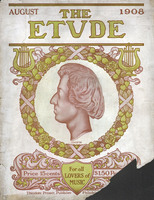Free advice upon musical subjects by experienced specialists. If there is anything you want to know tell us, and we will be glad to inform you or place your question in the hands of some acknowledged expert for reply. If the question is one of general interest to our readers we will print the answers here. This department is for you to use to any extent required.
The Etude cannot attempt to give metronomic markings for special compositions, as such information is of special rather than general interest. Metronomic markings are often purposely left off certain compositions by publishers and composers, to allow a reasonable latitude for the musical taste and technical limitations of the performer.
Constant Reader.—In reference to your inquiry pertaining to the Home for Aged Musicians, located at 236 South Third street, Philadelphia, we are pleased to inform you that you may have no hesitancy in endorsing this home in every respect. It has none of the aspects of an institution, but resembles a fine private residence in which the refined teacher may spend her declining years, entirely without the opprobrium of poverty. A good library and a fine meeting room make companionship in this home most pleasant. It was originally intended to provide for both lady and gentlemen teachers, but the directors of the home have decided to admit only lady teachers. Full particulars may be obtained by addressing the Secretary of the Home at the above address.
B. F. R.—The word temperament refers to the scientific and musical division of the Octave. Equal temperament is the name given for the modern system of tuning which divides the octave into twelve equal parts called semitones. Unequal temperament (which was formerly used for all keyed instruments and retained until quite recently for the organ) tuned the natural notes scientifically true and distributed the superfluous interval among the black keys. The discovery of the art of equally tempering the scale lies at the foundation of modern music. Without it the sudden excursions into remote keys would be impossible.
P. L. N.—The MacDowell fund according to latest information is to be devoted to the perpetuation of the MacDowell homestead at Peterboro, New Hampshire. Further information may be had by addressing Mrs. E. A. MacDowell, Peterboro, N. H.
New Reader.—The accepted fingering for the scale of B Major left hand is, ascending: 4, 3, 2, 1, 4, 3, 2, 1. It is the custom to start with the fourth finger on B, but in the other octaves the thumb comes on that note.
S. E. B.—In reference to the most desirable arrangement of the title and name on recital programs, we feel that it is better to have the name of the composer come first. This is not only a just compliment to the memory of the composer but also leads to a better appearing program owing to the more uniform length of the composers’ names. The method of having the name of the performer come first is not to be recommended for obvious reasons.
M. W. R.—We sympathize with you in your difficulty in exterminating moths. Moths rarely attack a piano that is in constant use, but you have assured us that your piano is used every day and is also in a light room. We do not think that you need have any fear of serious damage if the piano is sufficiently used. Camphor is not generally considered an insecticide, but rather a means of driving moths away through its offensive fumes. Persian insect powder is rarely of much value unless the room or piano is to be closed. You will find the so-called “camphor flakes” or “carbolated moth balls” much more valuable than real camphor for moths. Gasolene sprinkled around the edges of the carpets and under the piano has been found very effective in some cases although many people object to its use on account of its explosiveness. The writer has tried placing a sponge moistened with gasolene in a saucer in the piano. This was evidently effective as there were not any moths visible when the piano was opened in the fall.
D. J.—The various musical terms employed to indicate a gradual diminution of tone and speed are Morendo, Espirendo, Estinguendo, Sinnuendo, Smorendo, Smorzando, Mancando, Diminuendo. The following German terms may also be found: Schwinend. Sterbend, Verhallend, Verlöschend, Verschwindend.
The Xylophone, also known as Strohfiedel, Claque bois, Gielira, is a small wooden instrument in which the strips of wood are graduated to produce the diatonic scale. They are supported by ropes of straw and are struck by hammers held in each hand. It is rarely used in large orchestras, but is useful in producing certain effects in comic opera.
M. O.—The “Valse a deux Temps” is a species of Valse with two steps to each measure.



